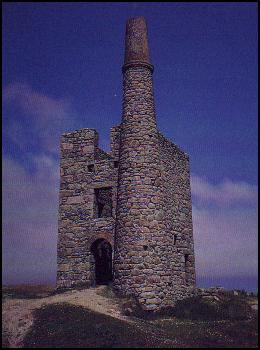


Cornwall's well known landmarks
For the majority of first time visitors to Cornwall, particularly if heading west from Truro, one of the most intriguing and impressive sights in the landscape are the Cornish engine houses. Standing on the horizon like miniature castles, engine houses have become as synonymous with Cornwall as clotted cream and pasties. Their construction dates back to a time when Cornwall was at the heart of the world's tin and copper supplies (some two thirds of total world output was being mined here during the 1850's) and led the world in its mining expertise and technical innovation.
Underground mines had been developed from around the 15th century although these were not deep and were often achieved by digging tunnels into exposed cliff faces in order to find the tin or copper bearing lodes. In order to exploit the ore deposits buried deep inland, a way would have to be found to prevent the continuous flooding of the shafts which became a major problem in the county.
The answer was steam power. Thomas Newcomen had built the world's first commercial steam engine in 1712, a design made more efficient by the work of James Watt fifty years later. Although these engines were further developed from 1800 onwards, it would take the son of a Cornish miner to make the breakthrough that would allow the Cornish mines to go deeper. The patenting of a high pressure engine by Richard Trevithick (now regarded as a hero in Cornwall - Trevithick Day is celebrated in Camborne each April), ensured that much greater quantities of water could be pumped from the mines and enabled more lodes of ore to be exploited. At its peak in the 1850's, the Cornish mining industry was utilising some 650 Cornish engines to pump water, crush the ore and to lift the ore and miners to the surface. The Perran Foundry at Perranarworthal and Harvey's of Hayle were building engines for work in Europe, America and Australia.
However, discovery of massive tin and copper deposits in South America and Asia in the 1870's led to a collapse in the Cornish mining industry. Massive emigration followed and mines closed in large numbers. At the end of their working lives, most engines were dismantled for scrap and the engine houses that protected them left to the elements or dismantled for building material. Fortunately, some enlightened individuals saw that an important part of Cornwall's, indeed Britain's heritage was gradually being lost. As a result, the Cornish Engines Preservation Society was set up in 1935 to try and protect those structures remaining. The society, renamed the Trevithick Society after the great man himself, was for example, instrumental with the National Trust in the preservation of the engine at the world famous Levant Mine near St. Just-in-Penwith.
Today, as a result of the National Trust's efforts, nearly 200 engine houses survive in Cornwall in some recognisable form (though only one mine, South Crofty at Camborne - the last working tin mine in Europe, continues the proud tradition of Cornish mining).
The following engine houses are good examples and available for close inspection.
Wheal Prosper, Rinsey.
Copper mine engine house, closed in 1865. Restored by the National Trust in 1971 who were so concerned to ensure it was retained in its original form that an old local quarry was re-opened to provide the correct stonework.
Levant, St. Just-in-Penwith.
One of the great names of Cornish mining and a working mine for over a century before its closure in 1930. The Building was restored by the National Trust; a team of volunteers 'the Greasy Gang' were responsible for bringing the engine back to working order.
Wheal Coates, St. Agnes.
The Towanroath Engine House of the Wheal Coates Mine dates from the early 1870's. Sited on a 200 foot cliff (the shaft in front of the engine house is over 600 feet deep!), the tin mine was not particularly successful in Cornish terms and closed only 20 years after opening.
East Pool Whim, Redruth.
The restored whim (winding) engine was set in motion again by the National Trust in 1975, having been idle for over 50 years. It was designed for lifting men and ore from a depth of 1,500 feet and was originally built in 1887 at the nearby Camborne foundry.
Crowns, Botallack Mine.
Two engine houses, dramatically situated on a rocky ledge above the sea, bear testament to the daring bravery of generations of Cornishmen who were involved in the battle for tin.
Botallack Mine East Pool Mine Levant Beam Engine Geevor Mine South Crofty Mine
Cornish Stannary (Tin) Law King Edward Mine Museum Mining in Cornwall